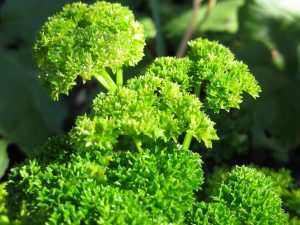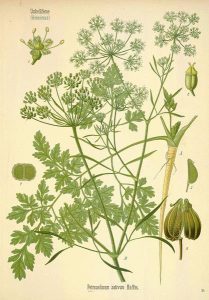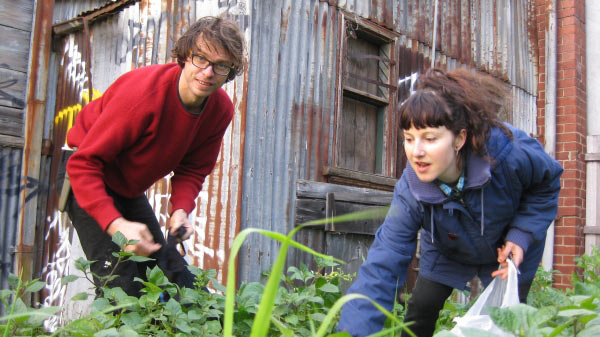 Petroselinum crispum
Petroselinum crispum
Family: Apiaceae
Parsley is a must in any self-respecting home garden, with culinary and medicinal uses that have been celebrated for centuries.
History
 Thought to have originated in the vicinity of Sardinia and Portugal, parsley has since spread to become an indispensable ingredient in Middle Eastern, European, American and Australasian cooking. The Ancient Greeks revered parsley, crowning their victors with garlands of parsley at the Isthmian games, and making wreaths with it for adorning the tombs of their dead.
Thought to have originated in the vicinity of Sardinia and Portugal, parsley has since spread to become an indispensable ingredient in Middle Eastern, European, American and Australasian cooking. The Ancient Greeks revered parsley, crowning their victors with garlands of parsley at the Isthmian games, and making wreaths with it for adorning the tombs of their dead.
Varieties
There are three distinct varieties of parsley, marked by different degrees of curliness. Most common are the ‘Flat leaf’ (or ‘Italian’) variety with its richer, more substantial flavour and the ‘Curly leaf’, known throughout the world as an attractive garnish with a delicious, clean mild taste. Less known is the ‘Parsnip rooted’ (or ‘Hamburg’) variety, which is grown particularly for its celery-like root.
Health and Nutrition
Parsley is pumped with so much goodness that small herbal halos can almost be seen above each super sprig. It’s high in minerals iron and calcium and vitamins A, B complex, C and E. Parsley works wonders for your innards, clearing toxins and stimulating the digestion. However, if you’re craving tubs of tabbouleh and you’re a mother-to-be, please hold off the from too much, as powerful parsley can act as an abortificant.
Cultivation
Parsley makes a brilliant border or edging plant and given its frequently picked status, a small forest of parsley is well sited near the kitchen door. Parsley is also shade tolerant and ideal for that spot in the garden that gets no sun in winter. You can extend the harvesting season of your parsley by regularly picking stems from the outside of the plant. Don’t despair if your seeds aren’t coming up, parsley seeds are notorious for slow germination and can take up to 20 days to sprout. Allow a circle about 15cm across for each plant. Parsley is reputed to be a good companion for asparagus and tomatoes.
Pests and diseases
Uncommon, though roots can rot in wet weather if drainage is inadequate (you’ll have no problems in a VEG bed).
Storage, uses and recipes
Chopped parsley leaves are added fresh to almost any meal as a garnish. Potatoes and parsley make an especially divine partnership on the plate. Dazzle your dinner guests with party-style parsley tempura (whole leaves dipped in batter and deep fried). At your next BBQ, try using sprigs of parsley as an edible brush when applying marinade. Parsley is an excellent breath-freshener and remarkably conceals the odours of raw onion and garlic.
Trivia
In Lebanon, parsley is a major ingredient in the national dish tabbouleh. An average adult may consume as much as 50g of parsley per meal.
Quotes
“I have never seen a garden with enough parsley,” Bill Mollison
“If parsley is thrown into fishponds it will heal the sick fishes therein,” William Turner, 1548



